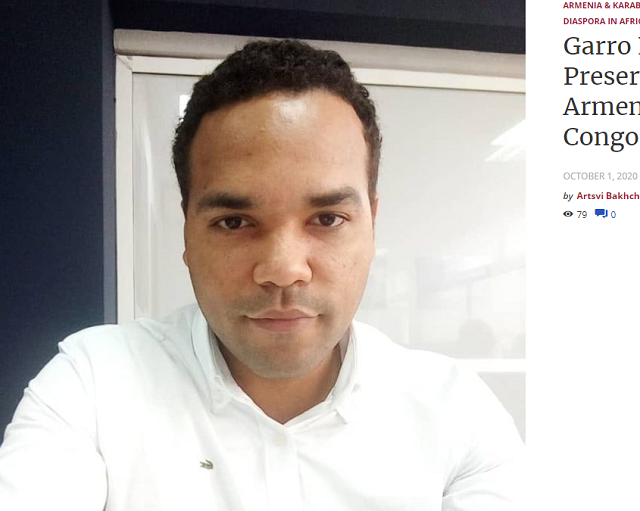The Armenian Mirror-Spectator. In Kinshasa, the capital of the Democratic Republic of Congo (DRC) with a population of 12 million inhabitants, a handful of Armenians live.
During the period when the country was colonized by Belgium (1908-1960), very few Armenians lived and worked there. Veterinarian Hovhannes Mahdessian served in the Congo’s colonial government for ten years before being repatriated in 1947. Several buildings were built in Congo by the design of French-Armenian architect Kevork Arsenian (1898-1980). Mateo (Megerdich) Margosian was called the “cigar baron” of Congo. Among the Congolese were followers of the Armenian Apostolic Church — in the 1960s, a group of converts came to Holy Echmiadzin for ordaining and after they organized the Armenian Church of Zaire. In 1984 according to a statistics there were 100 Armenians in Congo. Today their number is less, but the Armenians living in Congo are always in touch with each other. In addition to those from the Middle East, there are also those born from the marriages of French-Armenian and Belgian-Armenian businessmen and local women…
My conversation is with one of them — young businessman Garro Nanikian. The son of an Armenian father and Bantu mother, Garro studied at the Protestant University of Congo, manages the SCS Company, which is engaged in the development of professional sports. This handsome young man is known in Kinshasa as the organizer of boxing and other martial arts competitions, and for some time he presided over the Armenian community of Congo…
Dear Garro, what is the sports arena like in Congo and what is your role in it?
Read also
We live in a country that promotes sports. The sports arena in Congo was really satisfactory until COVID slowed down activities. In fact, since the advent of social media and the fall in the price of sports channels, the Congolese have become more involved in sports than ever before. In fact, since the spreading of social network and downward of price sport channel contents Congolese people are more involved in sport than past years. Currently I am a fight sport promoter and I play a role as boxing matchmaker for Police of DRC.
For about 15 years I have been interested in the history of Armenian presence in Africa, particularly, in Eastern and Western, Central and South Africa. As far as I can see, the first generation is consisted hardworking businessmen and entrepreneurs from Middle East. What was the case of your family?
My father, Berge Nanikian, is from Lebanon, who was established here within the framework of the UN stabilization program known as Monusco’s first mission in Congo. He then ran a business in Congo for many years, managing the firm UPHARCO. Now he is retired. He has many children: Jessica, Jo, Krikor, Antioche, Didier, Legite, Karin, Laetitia, Anthony, Catherine, Andreah, Olga, Jumelle… all of them are Nanikians and they all work in different fields of Congo life.
A half-Armenian, half-Nigerian young lady living in Yerevan once said that she is being considered too dark-skinned in Armenia and too light-skinned in Africa. Do you share her opinion?
This is a problem that is facing metis people everywhere. It is something that some people make you feel with their attitude. If people do not make you feel that you will not feel that.
Usually the new generation do not know from what part of Armenia their ancestors hailed. What about you?
I have an idea but not in detail. I am more connected with my family from my mother’s origin. I keep contact with my father’s family as well.
Do you have you any idea how many Armenians reside in Congo and what their main occupations are?
We were able to find out that six Armenian families live in Congo. Some Armenians come to work temporarily. Armenians work in the Congo in various fields: construction, insurance, administration, mining and trade. They are united on the “Armenian Community of Congo” Facebook group. They are mainly from Lebanon and Syria.
What kind of Armenian events have you organized in Kinshasa?
When I was the president of the Armenian community in Congo, I organized a community meeting. Kinshasa Armenians celebrate birthdays and weddings together; they make greeting and farewell parties for compatriots that work in Congo for a while. Thanks to my efforts as well as those of Valéry Safarian, president of the Armenian-Belgian Chamber of Commerce in Congo, Armenian-Belgian professional boxer Alex Miskirtchian, the former EBU Featherweight Champion, competed in Kinshasa twice: he defeated Congolese boxing champion Bilindo Eseko.
You speak several languages, including Lingala. What about Armenian?
I am learning Armenian, I know some words. I learn some things from Lebanese-Armenians living in Congo, but I study more by myself, through online courses, as well as from Armenian songs.
You have visited Armenia once – how would you describe your experience?
Very fine, I loved it very much. I made new friends. I admired Yerevan and Garni. It was in May 2017. I was invited to participate in a meeting initiated by the “Belgium-Armenia” Chamber of Commerce in Yerevan with the participation of businessmen from Armenia, Belgium and Congo. Armenia is a colorful country that succeeds to marry the traditional to the modernity. It was a wonderful experience.
I congratulate you again with the birth of your daughter, Hayastan Maria. While in Armenia many people give their children non-Armenian names, and you call your daughter Hayastan.
Thank you! I just want to preserve my Armenian roots in every way.

























































